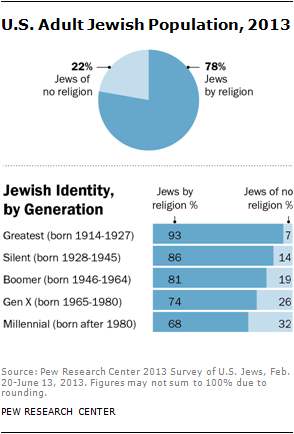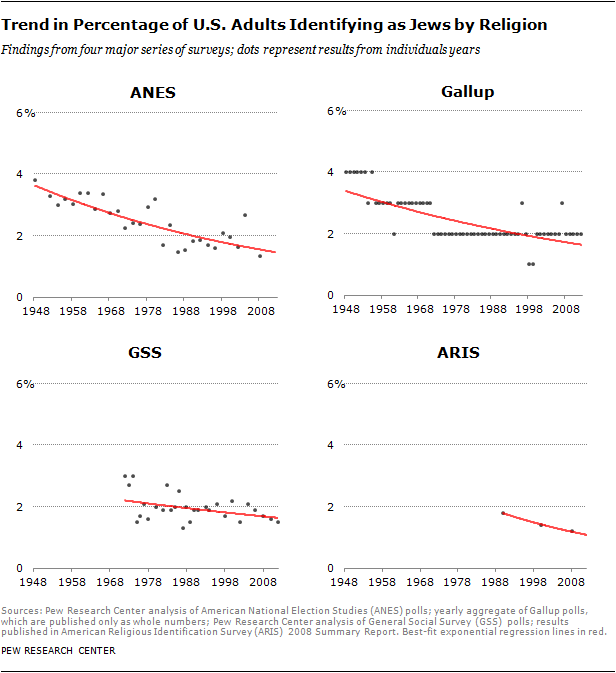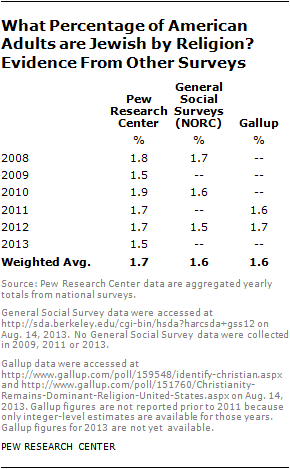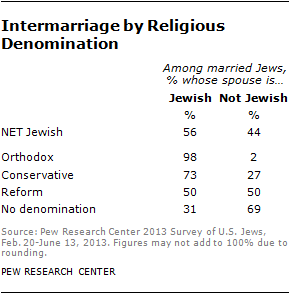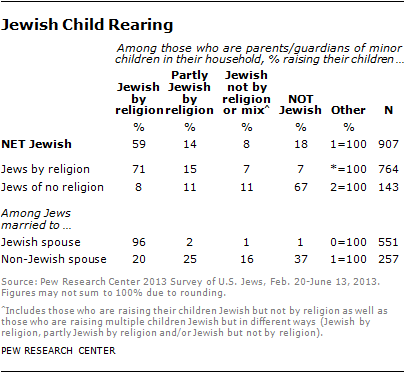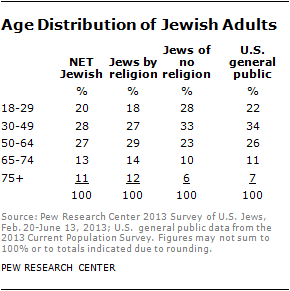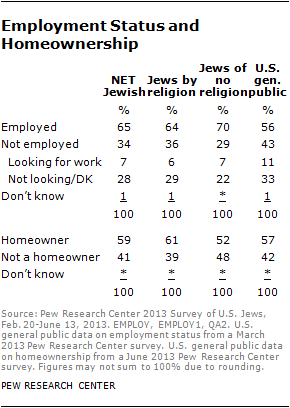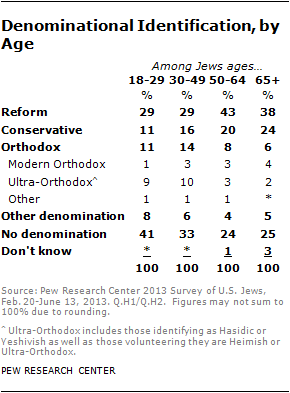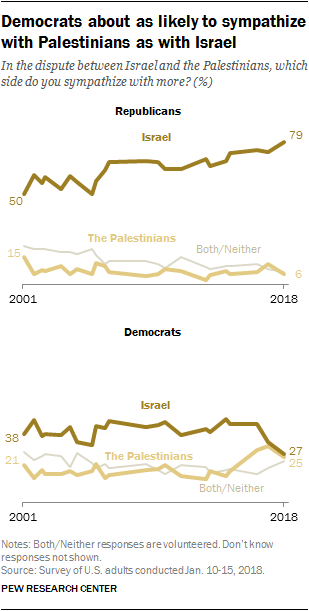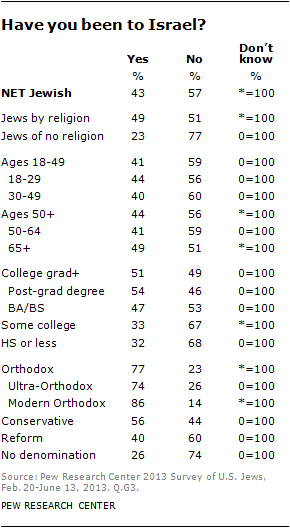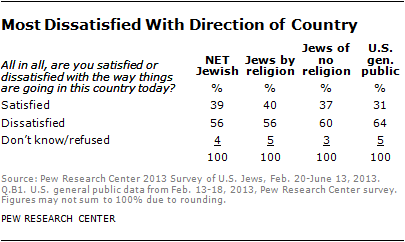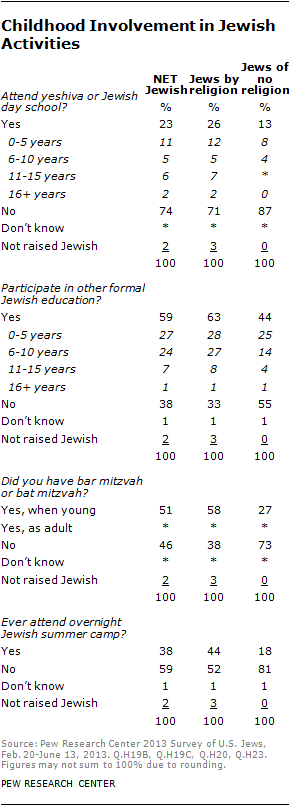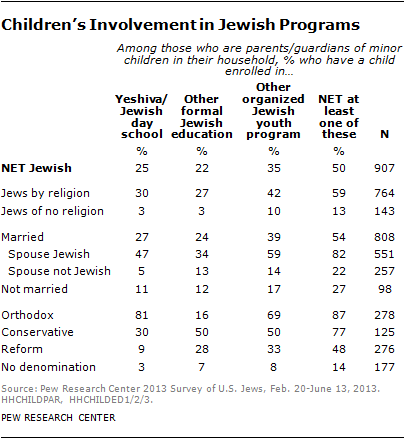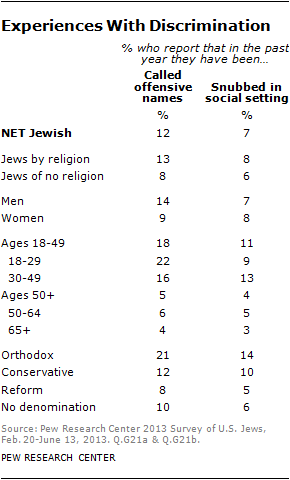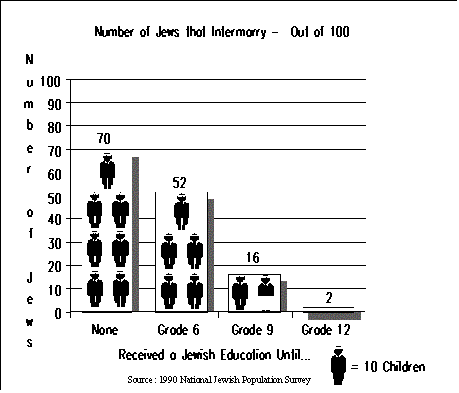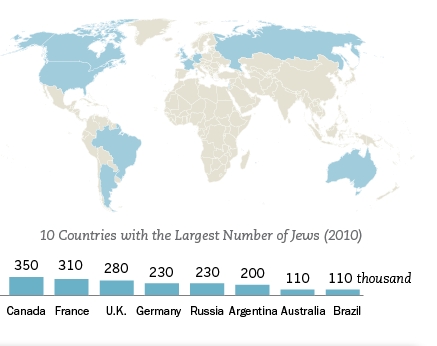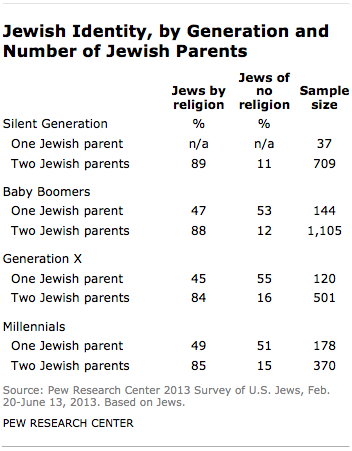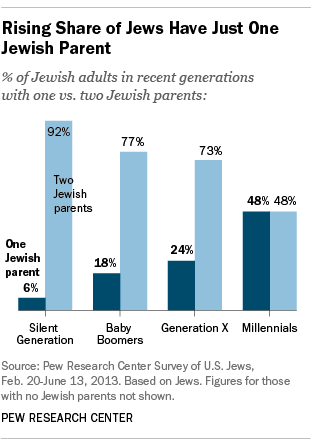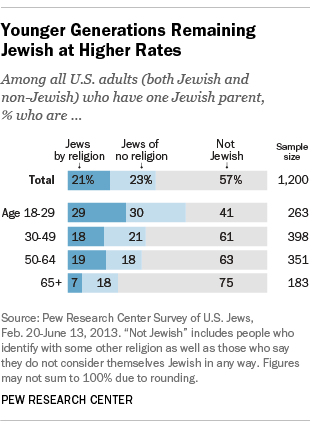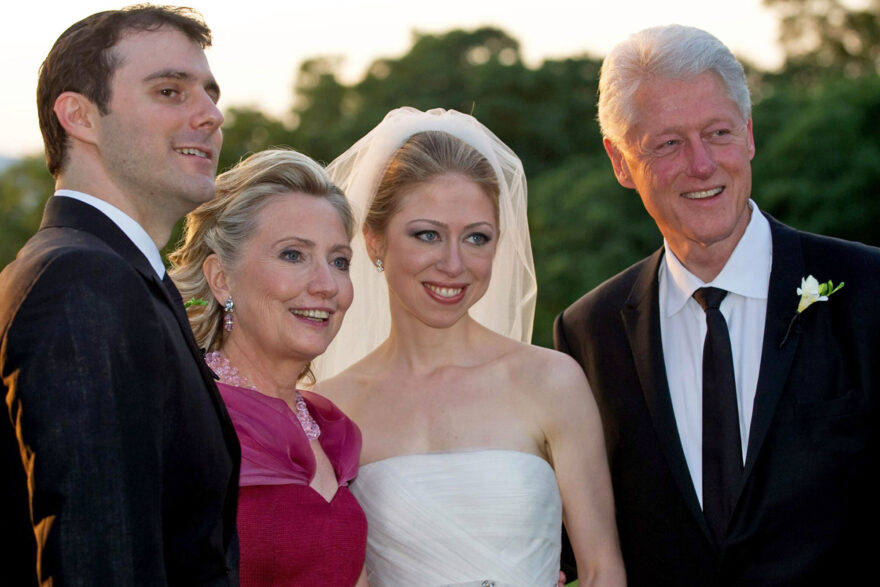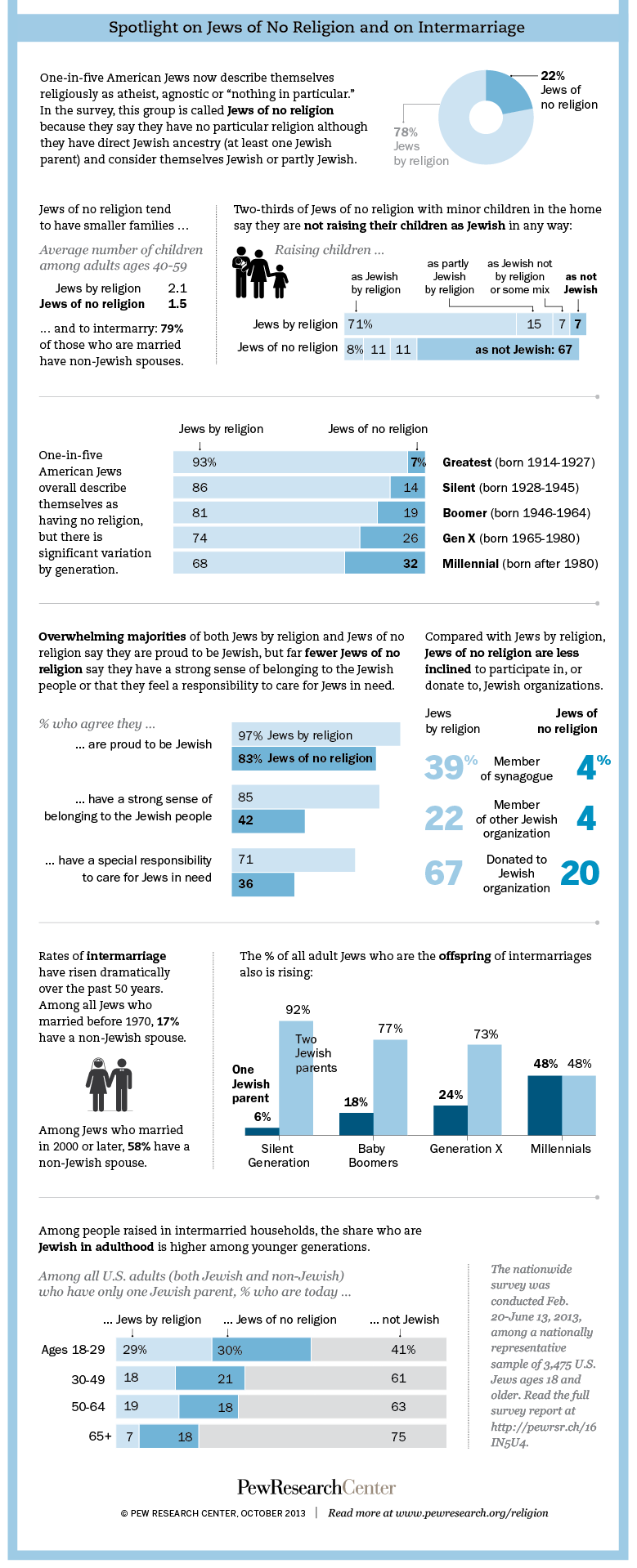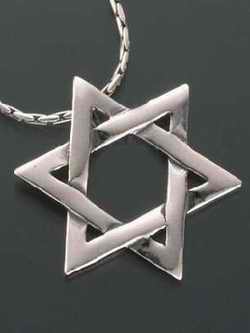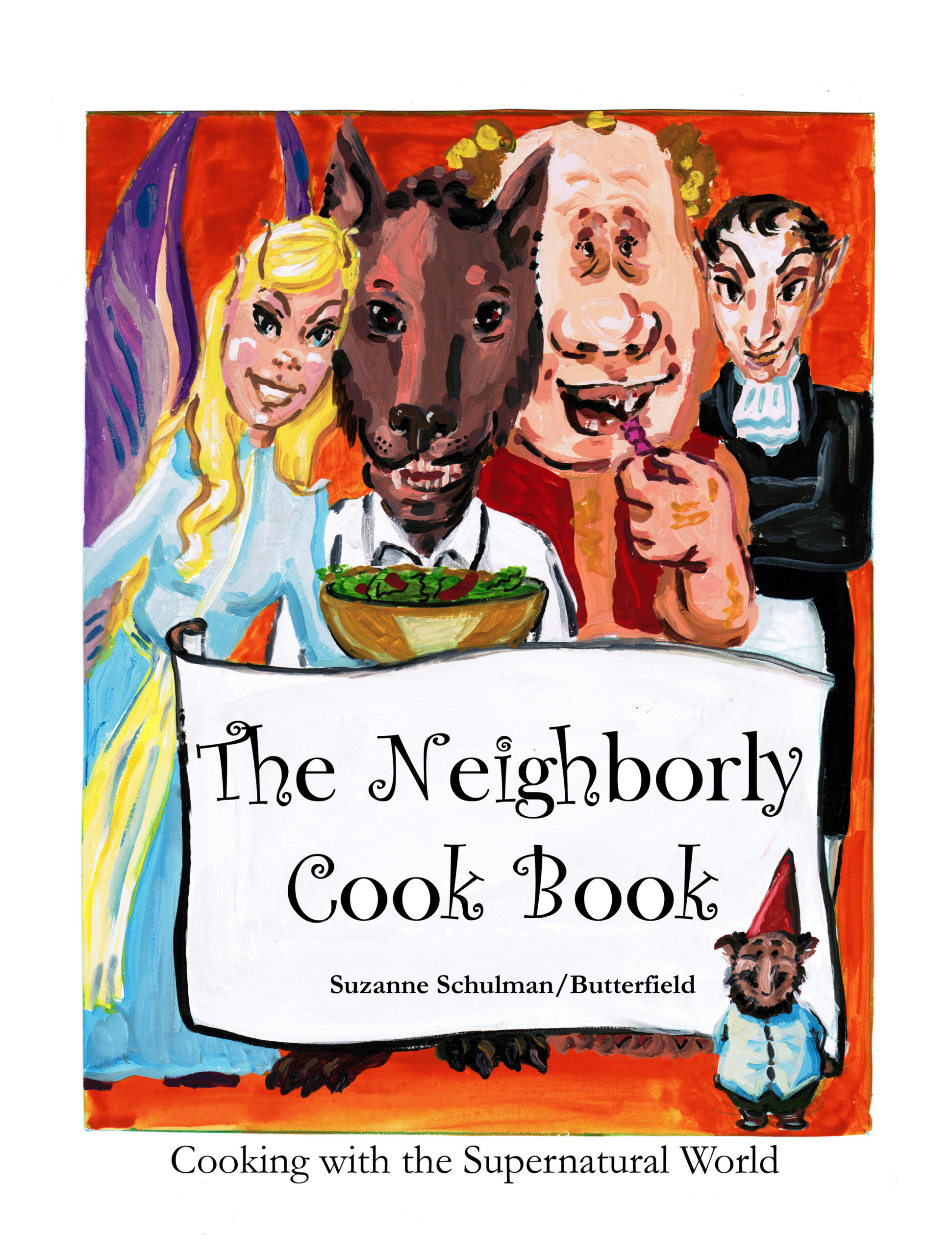 The Pew Research Religion and Public life project has done a survey of the Jewish American population. Jews are getting older, poorer, have a high intermarriage rate, and Jews are not raising their children Jewish, creating a loss of Jewish Identity † |
|||||||||||||||||||

|
|
||||||||||||||||||
jewish-american-full-report-for-web-2013These are among the key findings of the Pew Research Center’s survey of U.S. Jews, conducted on landlines and cellphones among 3,475 Jews across the country from Feb. 20-June 13, 2013, with a statistical margin of error for the full Jewish sample of plus or minus 3.0 percentage points. |
|||||||||||||||||||
There are 6,186,100 Jews in Israel, of which 16,968 are new immigrants1,620,000 Jews outside Israel and U.S.as of 2010 (Pew Research)According to Pew, August 29, 2018 (The Religious Typology – A new way to categorize Americans by religion) 42% of Jews have completely abandoned their tradition, 25% called themselves Solidly Secular – The least religious of the seven groups, relatively affluent, highly educated, mostly white and male, reject all New Age beliefs as well as belief in the God of the Bible or any higher power at all. “For the purposes of this analysis, Jews are defined as people who identify their religion as Judaism – what sociologists call “Jews by religion” – and not those who say they have no religion but identify as Jewish in other ways, such as culturally or ethnically.” Meaning, those Jewish respondents reject Judaism, God, ritual, prayer and religion, but still defined themselves as Jewish in terms of their religion. |
|||||||||||||||||||
|
If Jewish refers only to people whose religion is Jewish (Jews by religion), then the survey indicates that the Jewish population currently stands at about 1.8% of the total U.S. adult population, or 4.2 million people. In traditional Jewish law (halakha), Jewish identity is passed down through matrilineal descent, and the survey finds that about 90% of Jews by religion and 64% of Jews of no religion – a total of about 4.4 million U.S. adults – say they have a Jewish mother. Additionally, about 1.3 million people who are not classified as Jews in this report (49% of non-Jews of Jewish background) say they have a Jewish mother. Trends in the Size of the Jewish PopulationUsing the 1957 Current Population Survey as a benchmark, it appears that the number of adult Jews by religion rose about 15% over the last half-century, while the total U.S. population more than doubled over the same period.12 As a result, national surveys that repeatedly have asked Americans about their religion (Gallup, the American National Election Studies, the General Social Surveys and the American Religious Identification Surveys) show a decline, over the long term, in the percentage of U.S. adults who say their religion is Jewish…
How Do These Estimates Compare With Previous Estimates?
Comparisons between surveys of U.S. Jews are complicated by differences in their sampling methods, question wording and definitions of who counts as Jewish. Probably the most frequently cited previous estimate of the size of the American Jewish population is from the 2000-2001 National Jewish Population Survey, which came up with a figure of 5.2 million adults and children in the “core” Jewish population These are among the key findings of the Pew Research Center’s survey of U.S. Jews, conducted on landlines and cellphones among 3,475 Jews across the country from Feb. 20-June 13, 2013, with a statistical margin of error for the full Jewish sample of plus or minus 3.0 percentage points. The new survey also finds that seven-in-ten Jews (70%) say they participated in a Passover meal (Seder) in the past year, and 53% say they fasted for all or part of Yom Kippur in 2012. Compared with Jews by religion, however, Jews of no religion (also commonly called secular or cultural Jews) are not only less religious but also much less connected to Jewish organizations and much less likely to be raising their children Jewish. More than 90% of Jews by religion who are currently raising minor children in their home say they are raising those children Jewish or partially Jewish. In stark contrast, the survey finds that two-thirds of Jews of no religion say they are not raising their children Jewish or partially Jewish – either by religion or aside from religion. Intermarriageintermarriage by religious denomination 2013-PewIntermarriage is a related phenomenon. It is much more common among secular Jews in the survey than among Jews by religion: 79% of married Jews of no religion have a spouse who is not Jewish, compared with 36% among Jews by religion. And intermarried Jews, like Jews of no religion, are much less likely to be raising their children in the Jewish faith. Nearly all Jews who have a Jewish spouse say they are raising their children as Jewish by religion (96%). Among Jews with a non-Jewish spouse, however, 20% say they are raising their children Jewish by religion, and 25% are raising their children partly Jewish by religion. Roughly one-third (37%) of intermarried Jews who are raising children say they are not raising those children Jewish at all. Moreover, intermarriage rates seem to have risen substantially over the last five decades. Among Jewish respondents who have gotten married since 2000, nearly six-in-ten have a non-Jewish spouse. Among those who got married in the 1980s, roughly four-in-ten have a non-Jewish spouse. And among Jews who got married before 1970, just 17% have a non-Jewish spouse.3 The survey finds a strong association between secular Jews and religious intermarriage. Married Jews of no religion are much more likely than married Jews by religion to have non-Jewish spouses. Jews who have non-Jewish spouses are much less likely than those married to fellow Jews to be raising children as Jewish by religion and much more likely to be raising children as partially Jewish, Jewish but not by religion, or not Jewish at all. Furthermore, Jews who are the offspring of intermarriages appear, themselves, to be more likely to intermarry than Jews with two Jewish parents. The new Pew Research survey finds that, overall, 56% of married Jews have a Jewish spouse, while 44% of Jewish respondents are married to a non-Jew. Among Jews by religion who are married, 64% have a Jewish spouse and 36% have a non-Jewish spouse. By comparison, Jews of no religion are much more likely to be in mixed marriages; just 21% of married Jews of no religion are married to a Jewish spouse, while 79% are married to a non-Jewish spouse. Jewish Child RearingCompared with Jews by religion, however, Jews of no religion (also commonly called secular or cultural Jews) are not only less religious but also much less connected to Jewish organizations and much less likely to be raising their children Jewish. More than 90% of Jews by religion who are currently raising minor children in their home say they are raising those children Jewish or partially Jewish. In stark contrast, the survey finds that two-thirds of Jews of no religion say they are not raising their children Jewish or partially Jewish – either by religion or aside from religion. FertilityJewish adults ages 40-59 report having had an average of 1.9 children, compared with an average of 2.2 children per adult in the same age cohort of the general public. Jews by religion average more children (2.1) than Jews of no religion (1.5), and the average number of children born to Orthodox Jews (4.1) is about twice the overall Jewish average. By contrast, Reform Jews have 1.7 children and Conservative Jews have 1.8 children, on average. Jewish respondents married to Jewish spouses have more children on average than Jews married to non-Jews (2.8 vs. 1.8), and married Jews have more children than those who have never been married (2.3 vs. 0.2). In other words “Intermarriage and wives who prefer careers, than children are the demise of non Torah Jews. Sorry, but one or two children does not increase our numbers.”
|
|||||||||||||||||||
| 18-29 | 30-49 | 50-64 | 65+ | Sample Size | |
|---|---|---|---|---|---|
| 2014 | 22% | 27% | 26% | 26% | 825 |
| 2007 | 20% | 29% | 29% | 22% | 664 |
Household Composition
On average, Jews live in households with 2.7 people, including 2.2 adults and 0.5 children. Jews by religion and Jews of no religion tend to live in households of similar size (an average of 2.7 people per household among both groups).
Orthodox Jews tend to live in larger households than Jews of other denominational movements. The average Orthodox household contains 1.7 children, compared with 0.3 children per household with a Conservative respondent and 0.4 children per household with a Reform respondent.
Jewish Unemployment
Roughly two-thirds of Jewish adults say they are currently employed. One-third are not employed, including 7% who are currently looking for work. About six-in-ten Jews say they own their home.
one-fifth of all U.S. Jews report annual household incomes of less than $30,000. Jews with household incomes less than $30,000 are concentrated among young adults and those who have reached retirement age; 38% of Jews under age 30 say they have family incomes of $30,000 or less, as do 24% of Jews 65 and older. By contrast, 16% of Jews ages 30-49 have household incomes of $30,000 or less, and just 11% of Jews ages 50-64 fall into this income bracket.
Jewish Denomination Identity
Though Orthodox Jews constitute the smallest of the three major denominational movements, they are much younger, on average, and tend to have much larger families than the overall Jewish population. This suggests that their share of the Jewish population will grow.
Jewish Practices
Regularly lighting candles to mark the start of the Sabbath is less common among Jews than participating in a Seder or fasting on Yom Kippur, as is keeping a kosher home. Nearly a quarter of Jews (23%) say they always or usually light Sabbath candles (down slightly from 28% in the 2000-2001 NJPS), and a similar number say they keep kosher in their home (22%).
As with other traditional practices, Orthodox Jews are much more likely than other Jews to say they regularly light Sabbath candles and keep kosher homes. Similarly, Jews married to a Jewish spouse perform these activities at much higher rates than intermarried Jews.
One-in-seven Jews say they avoid handling money on the Sabbath (13%). However, most Orthodox Jews continue to maintain this traditional Sabbath observance.
Roughly four-in-ten U.S. Jewish adults (39%) say they live in a household where at least one person is a member of a synagogue. This includes 31% of Jewish adults (39% of Jews by religion and 4% of Jews of no religion) who say they personally belong to a synagogue, temple or other congregation.
Combining Judaism and Other Faiths
About a third of Jews (32%) say they had a Christmas tree in their home last year, including 27% of Jews by religion and 51% of Jews of no religion. Erecting a Christmas tree is especially common among Jews who are married to non-Jews; 71% of this group says they put up a tree last year.
Republicans and Democrats Grow Even Further Apart in Views of Israel, Palestinians
The partisan divide in Middle East sympathies, for Israel or the Palestinians, is now wider than at any point since 1978. Currently, 79% of Republicans say they sympathize more with Israel than the Palestinians, compared with just 27% of Democrats.
January 23, 2018 https://www.people-press.org/2018/01/23/republicans-and-democrats-grow-even-further-apart-in-views-of-israel-palestinians/
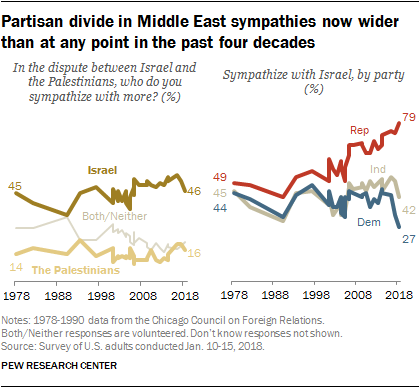
Pew-2018 Partisan divide in Middle east sympathies now wider then in the last four decades. US Republicans US Democrats
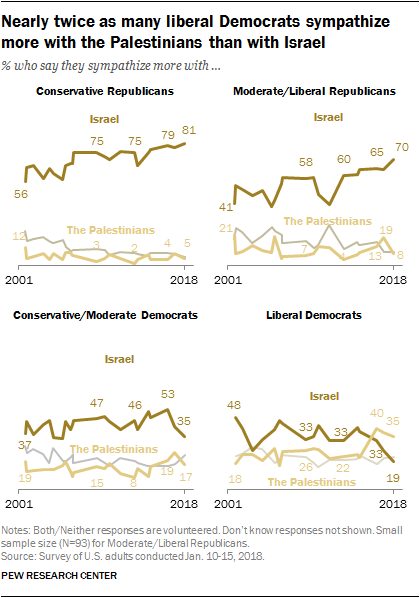
Pew-2018: Nearly twice as many liberal Democrats sympathize more with the Palestinians than with Israel
The partisan divide in Middle East sympathies, for Israel or the Palestinians, is now wider than at any point since 1978. Currently, 79% of Republicans say they sympathize more with Israel than the Palestinians, compared with just 27% of Democrats.
Since 2001, the share of Republicans sympathizing more with Israel than the Palestinians has increased 29 percentage points, from 50% to 79%. Over the same period, the share of Democrats saying this has declined 11 points, from 38% to 27%.
The latest national survey by Pew Research Center, conducted Jan. 10-15 among 1,503 adults, finds that 42% say Donald Trump is “striking the right balance” in the situation in the Middle East, while 30% say he favors Israel too much (just 3% say Trump sides too much with the Palestinians; 25% do not offer an opinion).
At a similar point in Barack Obama’s presidency, 47% of Americans said he had struck a proper balance in dealing with the Middle East; 21% said he sided too much with the Palestinians, while 7% said he favored Israel too much.
The survey finds that while Republicans and Democrats are deeply divided in views of Israel, so too do they differ markedly in opinions about Benjamin Netanyahu, Israel’s prime minister. Nearly three times as many Republicans (52%) as Democrats (18%) have favorable impressions of Israel’s leader.
About half of Americans say a two-state solution is possible in the Middle East: 49% say a way can be found for Israel and an independent Palestinian state “to coexist peacefully,” while 39% say this is not possible. Democrats are far more likely than Republicans to say a two-state solution is possible (58% vs. 40%).
Republicans increasingly sympathize with Israel; Democrats are divided
When asked about the dispute between Israel and the Palestinians, 46% of Americans say they sympathize more with the Israelis, 16% say they sympathize more with the Palestinians and about four-in-ten (38%) either volunteer that their sympathies are with both (5%), neither (14%) or that they do not know (19%). The overall balance of opinion has fluctuated only modestly since 1978, when 45% said they sympathized more with Israel, 14% with the Palestinians and 42% could not decide.
But the partisan divide has widened considerably, especially over the past two decades. The share of Republicans who sympathize with Israel has never been higher, dating back four decades.
Nearly eight-in-ten Republicans (79%) sympathize more with Israel than the Palestinians, while just 6% sympathize more with the Palestinians; another 7% say they sympathize with both or neither, while 9% say they do not know.
As was the case last year, Democrats are divided in views of the Middle East conflict: Currently, 27% of Democrats say they sympathize more with Israel, while 25% say they sympathize more with the Palestinians; another 23% say they sympathize with neither or both sides and one-quarter (25%) say they don’t know. Democrats also were divided last year, when 33% said they sympathized with Israel and 31% said the Palestinians. Since then, the share of Democrats saying they don’t know has increased from 17% to 25% and the share saying they sympathize with both or neither has ticked up slightly from 19% to 23%.
As recently as two years ago, in April 2016, Democrats were more likely to sympathize more with Israel (43%) than with the Palestinians (29%), with 16% saying they sympathized with both or neither.
Among Democrats, the decline over the last few years in those who say they sympathize more with Israel is seen both among liberals and among conservatives and moderates.
Travel to Israel
More than four-in-ten American Jews (43%) have been to Israel, including 23% who have done so more than once. More than twice as many Jews by religion as Jews of no religion report having visited the Jewish state (49% vs. 23%).
Orthodox Jews are more likely than American Jews of any other denomination to have traveled to Israel; 77% have done so, followed by 56% of Conservative Jews, 40% of Reform Jews and 26% of those who have no denominational affiliation.
Satisfaction With Country, Communities
Most Jews are dissatisfied with the way things are going in the country today; 56% say they are dissatisfied, compared with 39% who are satisfied.
Jewish Education
Half of Jews (52%), including 60% of Jews by religion and 24% of Jews of no religion, say they know the Hebrew alphabet. But far fewer (13% of Jews overall, including 16% of Jews by religion and 4% of Jews of no religion) say they understand most or all of the words when they read Hebrew.
Jews by religion are more likely to have participated in these kinds of programs than are Jews of no religion. But even among Jews of no religion, sizable minorities say they attended yeshiva or day school (13%) or some other kind of Jewish educational program (44%).
Roughly half of Jews (51%) say they have had a bar mitzvah or a bat mitzvah. Most Jews by religion have undergone this rite of passage (58%), whereas about one-quarter of Jews of no religion have had a bar mitzvah or bat mitzvah.
More than one-third of Jews say they attended an overnight Jewish summer camp as a child, including 44% of Jews by religion who say they had this experience. Fewer Jews of no religion (18%) say they spent time at an overnight Jewish summer camp.
Jews from the former Soviet Union
Jews from the former Soviet Union and their offspring account for roughly one-tenth of the U.S. Jewish population; 5% of Jewish adults say they were born in the former Soviet Union, and an additional 6% say they were born in the U.S. but have at least one parent who was born in the former Soviet Union.
Discrimination Against Jews
Jews do face a lot of discrimination (43%).
And Jews are more likely than the population as a whole to say that Jews face a lot of discrimination in the U.S. today (43% vs. 24% among the general public).
About the Survey
![]() Click on the pdf to download the questionnaire
Click on the pdf to download the questionnaire
Pew-Research-Jewish-American-Questionnaire-2013
These are some of the findings of the new Pew Research Center survey, conducted Feb. 20-June 13, 2013, among a nationally representative sample of U.S. Jews. This is the most comprehensive national survey of the Jewish population since the 2000-2001 National Jewish Population Survey. More than 70,000 screening interviews were conducted to identify Jewish respondents in all 50 states and the District of Columbia. Longer interviews were completed with 3,475 Jews, including 2,786 Jews by religion and 689 Jews of no religion.
Interviews were conducted in English and Russian by random digit dialing on both landlines and cellphones. In order to reach Jewish respondents most efficiently, the survey focused on telephone exchanges for counties where previous surveys indicate that at least some Jews reside. Overall, the survey covered geographic areas that are home to more than 90% of U.S. adults. Counties were excluded from the survey only if (a) no Jews had been interviewed in those counties in more than 150 Pew Research Center surveys conducted over the past decade and (b) no other surveys in a Brandeis University database had ever interviewed a Jew in those counties and (c) no synagogues or institutions of Jewish education were known to be located in those counties at the time of the Pew Research survey.6 Based on this geographic coverage, more than 95% of the Jewish population, including 99% of the Jewish by religion population, is estimated to have been eligible to be called for the survey
Caroline Glick The American Jewish Community’s Moment to Choose
It’s time to come home! Nefesh B’Nefesh: Live the Dream 1-866-4-ALIYAH
The 10 advantages of a Jewish education
http://www.torahkids.org/
1. Safe Environment With a Jewish education, children are in good hands!
2. Intermarriage Prevention With a Jewish education, our family’s Jewish future is safe.
3. Secular Education With a Jewish education, children are better equipped to enter society at all levels.
4. Family Life With a Jewish education, kids bring home peace and happiness.
5. Meaningful Life With a Jewish education, our child lives a meaningful life.
6. Happiness in Life With a Jewish education, our child lives a happier life.
7. Noble Values A Jewish education teaches a child to be a better person.
8. Jewish Identity A Jewish education protects a child from cults and missionaries.
9. Jewish Survival With a Jewish education, our people survive.
10. Our Heritage With a Jewish education, a child develops pride in being Jewish.
Q. What are the statistics regarding assimilation for those that attended public schools vs. those that attended an Orthodox Jewish Day school or Yeshiva?
A. 70 out of 100 children that didn’t receive a Jewish education (ie, went to public schools) ultimately intermarried. In comparison, of those that attended a Jewish school until grade 12 – 2 out of 100 intermarried. See chart below.
Q. I believe that it is important that a child receive a proper Jewish Education – but I want my child to make the decision on their own.
A. Sometimes a child does not recognize the importance of an issue – so prudent parents must make the right decision for their child’s best interest. A prudent parent will not acquiesce to a child’s refusal to take medicine if it is for their best interest.
If there is a court case between two parties – a judge listens to the story of both. If he did not, he would be partial and could not judge fairly. The only way for a child to properly decide for themselves is to be exposed to both an education comprised of both a secular and Torah education. Placing a child in a Torah day school will allow the child to be impartial – because they will receive both sides of the story.
Q. What is so bad if I send my Jewish child to a Public or Secular Private School?
A. Depriving a child of a Torah education may cause your child to not reach a true level of meaning in life and satisfaction. Top Psychologists say that this deprivation is the main source of many problems later on in life.
A person is composed of a body and a soul. A true Torah education is what the soul yearns for. Upon reaching adulthood many of these children – who were not taught the beauty and excitement of following the Torah – go off to far away countries in search of spirituality, join cults, participate in foreign rituals – because their parents deprived them of a Torah education.
A Yeshiva gives a child a well rounded education.
1) An excellent secular education with all the amenities of a secular school
2) An excellent Jewish Education
Together these give a Jewish child the tools to succeed materially, psychologically, mentally and spirtually.
But more importantly, the adherence to a Torah life, allows a child to be happy in this world. And for every word of Torah they learn, they receive an eternal reward – meaning once they reach the next world. If you are really concerned about the long term good of the child – their is no better education that you can provide than an authentic Torah education.
Tuition United States VS Israel
Los Angeles, California
Yeshiva University High Schools of Los Angeles (YULA)
$29,300 per student
Valley Torah High School Los Angeles CA
$23,350 per student
Jerusalem, Israel 3.55 Israeli New Shekel/Dollar
Tehilla – Evelina De Rothschild (7-12)
5,500 NIS or $1,550 per student
3,000 NIS or $846 per student

Pew:What happens when Jews intermarry?
By Gregory A. Smith and Alan Cooperman
November 12, 2013 http://www.pewresearch.org/fact-tank/2013/11/12/what-happens-when-jews-intermarry/
American Jews have been debating the impact of intermarriage for decades. Does intermarriage lead to assimilation and weaken the Jewish community? Or is it a way for a religion that traditionally does not seek converts to bring new people into the fold and, thereby, strengthen as well as diversify the Jewish community? The new Pew Research Center survey of U.S. Jews did not start this debate and certainly will not end it. However, the survey’s findings on intermarriage, child rearing and Jewish identity provide some support for both sides.
For example, the survey shows that the offspring of intermarriages – Jewish adults who have only one Jewish parent – are much more likely than the offspring of two Jewish parents to describe themselves, religiously, as atheist, agnostic or nothing in particular. In that sense, intermarriage may be seen as weakening the religious identity of Jews in America.
Yet the survey also suggests that a rising percentage of the children of intermarriages are Jewish in adulthood. Among Americans age 65 and older who say they had one Jewish parent, 25% are Jewish today. By contrast, among adults under 30 with one Jewish parent, 59% are Jewish today. In this sense, intermarriage may be transmitting Jewish identity to a growing number of Americans.
Surveys are snapshots in time. They typically show associations, or linkages, rather than clear causal connections, and they don’t predict the future. We do not know, for example, whether the large cohort of young adult children of intermarriage who are Jewish today will remain Jewish as they age, marry (and in some cases, intermarry), start families and move through the life cycle. With those cautions in mind, here’s a walk through some of our data on intermarriage, including some new analysis that goes beyond the chapter on intermarriage in our original report. (We would like to thank several academic researchers, including Theodore Sasson of Brandeis University, Steven M. Cohen of Hebrew Union College and NYU Wagner, and Bruce Phillips of Hebrew Union College and the University of Southern California, for suggesting fruitful avenues of additional analysis.)
First, intermarriage is practically nonexistent among Orthodox Jews; 98% of the married Orthodox Jews in the survey have a Jewish spouse. But among all other married Jews, only half say they have a Jewish spouse.
In addition, intermarriage rates appear to have risen substantially in recent decades, though they have been relatively stable since the mid-1990s. Looking just at non-Orthodox Jews who have gotten married since 2000, 28% have a Jewish spouse and fully 72% are intermarried.
Also, intermarriage is more common among Jewish respondents who are themselves the children of intermarriage. Among married Jews who report that only one of their parents was Jewish, just 17% are married to a Jewish spouse. By contrast, among married Jews who say both of their parents were Jewish, 63% have a Jewish spouse.
Among Jews, the adult offspring of intermarriages are also much more likely than people with two Jewish parents to describe themselves religiously as atheist, agnostic or just “nothing in particular.” This is the case among all recent generations of U.S. Jews.
For example, among Jewish Baby Boomers who had two Jewish parents, 88% say their religion is Jewish; hence, we categorize them as “Jews by religion.” But among Baby Boomers who had one Jewish parent, 53% describe themselves as atheist, agnostic or having no particular religion, even though they also say they consider themselves Jewish or partially Jewish aside from religion; they are categorized as “Jews of no religion” in the table. Far fewer Jewish Baby Boomers who had two Jewish parents (12%) are Jews of no religion today.
A similar pattern is seen among Jewish Millennials: 51% of Millennials who have one Jewish parent are Jews of no religion, compared with just 15% of Millennials who had two Jewish parents.
Summing this up, it appears that the share of Jews of no religion is similar – and relatively low – among recent generations of Jews with two Jewish parents. It is much higher (and also fairly similar across generations) among self-identified Jews with only one Jewish parent.
But it is also important to bear in mind that the percentage of Jewish adults who are the offspring of intermarriages appears to be rising. Just 6% of Jews from the Silent Generation say they had one Jewish parent, compared with 18% of Jewish Baby Boomers, 24% of Generation X and nearly half (48%) of Jewish Millennials. The result is that there are far more Jews of no religion among younger generations of Jews than among previous generations, as shown in the survey report.
When we look at all adults who have just one Jewish parent – including both those who identify as Jewish and those who do not – we see that the Jewish retention rate of people raised in intermarried families appears to be rising. That is, among all adults (both Jewish and non-Jewish) who say they had one Jewish parent and one non-Jewish parent, younger generations are more likely than older generations to be Jewish today.
For example, among U.S. adults ages 65 and older who had one Jewish parent, 25% are Jewish today (including 7% who are Jews by religion and 18% who are Jews of no religion), while 75% are not Jewish (meaning that they currently identify with a religion other than Judaism or that they do not consider themselves Jewish in any way, either by religion or otherwise). Among adults younger than 30 who have one Jewish parent, by contrast, 59% are Jewish today, including 29% who are Jews by religion and 30% who are Jews of no religion.
Finally, it has often been assumed that Jewish women are less inclined to intermarry than are Jewish men. As Bruce Phillips, a sociologist at Hebrew Union College in Los Angeles, has written: “In American popular culture, intermarriage has been the [domain] of Jewish males. Starting with ‘Abbie’s Irish Rose’ and ‘The Jazz Singer’ following the turn of the century through ‘Bridget Loves Bernie’ and the ‘Heartbreak Kid’ in the early 1970s to ‘Mad About You’ in the 1990s, the plot is about a Jewish married man in love with a stereotypical [non-Jewish woman].”
But our survey finds that Jewish women are slightly more likely to be intermarried than Jewish men. Among the married Jewish women surveyed, 47% say they have a non-Jewish spouse. Among the married Jewish men, 41% say they have a non-Jewish spouse.

Liberman, ‘troubled’ about US Jewry, warns the Diaspora is waning
Citing ‘very grave’ 2013 Pew survey, defense minister urges Jews to ‘pull themselves together’ and strengthen their identity
By Marissa Newman December 16, 2016 http://www.timesofisrael.com/liberman-troubled-about-us-jewry-warns-diaspora-waning/
Defense Minister Avigdor Liberman is “really troubled” about the state of American Jewry, he said Thursday, warning that if Diaspora Jews don’t “pull themselves together,” their ranks will be greatly depleted in less than two generations.
“One of the things that really troubles me is the whole issue of Judaism, of the Jewish people in exile,” said Liberman, an avowed secularist politician whose Yisrael Beytenu party has long sought to scale back government intervention in religious affairs.
Addressing Russian-speaking Jews at a Limmud FSU conference in the southern city of Eilat, the defense minister specifically voiced concerns about US Jews, citing the 2013 Pew survey that showed — among many things — that one-fifth of American Jews don’t call themselves “Jewish” when asked about their religion, and pegged the overall intermarriage rate at 58 percent, with a whopping 71% among the non-Orthodox.
“Whoever saw the last surveys by the Pew Center, the rates of assimilation, the connection between the new generation in the United States to Judaism — not just Israel –” ought to be concerned, he lamented, adding that more-distant attitudes toward the Jewish state were also worrisome.
“The picture [that emerges from the survey] is very grave,” Liberman warned. “If we don’t pull ourselves together, in a generation and a half, there will be nearly no Jewish people in the Diaspora, apart from Orthodox communities.”
As Israel prepares to approve its two-year budget, the government should allocate funds to strengthening Jewish identity abroad, he continued, noting that while the funds were there, what was lacking was the “priority.”
Israel has long depended the on support of Diaspora Jewry, Liberman added. “Now it is our turn to offer them a hand. For this, too, we can find money.
“We are fighting for the future and the survival of the Jewish people in the entire world — outside of Israel, outside of Orthodoxy,” he proclaimed.
As foreign minister in February 2014, Liberman voiced similar concerns, opining at one point that demographic shifts among global Jewry were a graver threat to the Jewish people than Iran.
“It must become the most pressing issue on the global Jewish agenda, Liberman told the Conference of Presidents of Major American Jewish Organizations that year. “More pressing than the Palestinian negotiations or the Iranian nuclear threat.”
“The Jews of America are facing nothing less than a demographic catastrophe,” he warned.
At the time, Liberman called for the establishment of a “global network of Jewish schools that are superior in standard to the American and international school network.” To reach that goal, he said, the Israeli government should dedicate $365 million per year, a sum he said he hoped Jewish communities in the Diaspora would be willing to match.
As foreign minister, he also said his aim was to convince 3.5 million Diaspora Jews to immigrate to Israel over the next 10 years, “so that the Jewish population in Israel will exceed 10 million.”
Raphael Ahren contributed to this report.
Israel has one of the lowest unemployment rates. It’s time to come home where the jobs are.
30 Mindblowing Statistics About Americans Under The Age Of 30
Submitted by Tyler Durden on 10/04/2013 19:03 https://www.zerohedge.com/news/2013-10-04/30-mindblowing-statistics-about-americans-under-age-30
Submitted by Michael Snyder of The Economic Collapse blog,
Why are young people in America so frustrated these days? You are about to find out. Most young adults started out having faith in the system. They worked hard, they got good grades, they stayed out of trouble and many of them went on to college. But when their educations where over, they discovered that the good jobs that they had been promised were not waiting for them at the end of the rainbow. Even in the midst of this so-called “economic recovery”, the full-time employment rate for Americans under the age of 30 continues to fall. And incomes for that age group continue to fall as well. At the same time, young adults are dealing with record levels of student loan debt. As a result, more young Americans than ever are putting off getting married and having families, and more of them than ever are moving back in with their parents. [wpex Read more]
It can be absolutely soul crushing when you discover that the “bright future” that the system had been promising you for so many years turns out to be a lie. A lot of young people ultimately give up on the system and many of them end up just kind of drifting aimlessly through life. The following is an example from a recent Wall Street Journal article…
James Roy, 26, has spent the past six years paying off $14,000 in student loans for two years of college by skating from job to job. Now working as a supervisor for a coffee shop in the Chicago suburb of St. Charles, Ill., Mr. Roy describes his outlook as “kind of grim.”
“It seems to me that if you went to college and took on student debt, there used to be greater assurance that you could pay it off with a good job,” said the Colorado native, who majored in English before dropping out. “But now, for people living in this economy and in our age group, it’s a rough deal.”
Young adults as a group have been experiencing a tremendous amount of economic pain in recent years. The following are 30 statistics about Americans under the age of 30 that will blow your mind…
#1 The labor force participation rate for men in the 18 to 24 year old age bracket is at an all-time low.
#2 The ratio of what men in the 18 to 29 year old age bracket are earning compared to the general population is at an all-time low.
#3 Only about a third of all adults in their early 20s are working a full-time job.
#4 For the entire 18 to 29 year old age bracket, the full-time employment rate continues to fall. In June 2012, 47 percent of that entire age group had a full-time job. One year later, in June 2013, only 43.6 percent of that entire age group had a full-time job.
#5 Back in the year 2000, 80 percent of men in their late 20s had a full-time job. Today, only 65 percent do.
#6 In 2007, the unemployment rate for the 20 to 29 year old age bracket was about 6.5 percent. Today, the unemployment rate for that same age group is about 13 percent.
#7 American families that have a head of household that is under the age of 30 have a poverty rate of 37 percent.
#8 During 2012, young adults under the age of 30 accounted for 23 percent of the workforce, but they accounted for a whopping 36 percent of the unemployed.
#9 During 2011, 53 percent of all Americans with a bachelor’s degree under the age of 25 were either unemployed or underemployed.
#10 At this point about half of all recent college graduates are working jobs that do not even require a college degree.
#11 The number of Americans in the 16 to 29 year old age bracket with a job declined by 18 percent between 2000 and 2010.
#12 According to one survey, 82 percent of all Americans believe that it is harder for young adults to find jobs today than it was for their parents to find jobs.
#13 Incomes for U.S. households led by someone between the ages of 25 and 34 have fallen by about 12 percent after you adjust for inflation since the year 2000.
#14 In 1984, the median net worth of households led by someone 65 or older was 10 times larger than the median net worth of households led by someone 35 or younger. Today, the median net worth of households led by someone 65 or older is 47 times larger than the median net worth of households led by someone 35 or younger.
#15 In 2011, SAT scores for young men were the worst that they had been in 40 years.
#16 Incredibly, approximately two-thirds of all college students graduate with student loans.
#17 According to the Federal Reserve, the total amount of student loan debt has risen by 275 percent since 2003.
#18 In America today, 40 percent of all households that are led by someone under the age of 35 are paying off student loan debt. Back in 1989, that figure was below 20 percent.
#19 The total amount of student loan debt in the United States now exceeds the total amount of credit card debt in the United States.
#20 According to the U.S. Department of Education, 11 percent of all student loans are at least 90 days delinquent.
#21 The student loan default rate in the United States has nearly doubled since 2005.
#22 One survey found that 70% of all college graduates wish that they had spent more time preparing for the “real world” while they were still in college.
#23 In the United States today, there are more than 100,000 janitors that have college degrees.
#24 In the United States today, 317,000 waiters and waitresses have college degrees.
#25 Today, an all-time low 44.2 percent of all Americans between the ages of 25 and 34 are married.
#26 According to the Pew Research Center, 57 percent of all Americans in the 18 to 24 year old age bracket lived with their parents during 2012.
#27 One poll discovered that 29 percent of all Americans in the 25 to 34 year old age bracket are still living with their parents.
#28 Young men are nearly twice as likely to live with their parents as young women the same age are.
#29 Overall, approximately 25 million American adults are living with their parents according to Time Magazine.
#30 Young Americans are becoming increasingly frustrated that previous generations have saddled them with a nearly 17 trillion dollar national debt that they are expected to make payments on for the rest of their lives.
And this trend is not just limited to the United States. As I have written about frequently, unemployment rates for young adults throughout Europe have been soaring to unprecedented heights. For example, the unemployment rate for those under the age of 25 in Italy has now reached 40.1 percent.
Simon Black of the Sovereign Man blog discussed this global trend in a recent article on his website…
Youth unemployment rates in these countries are upwards of 40% to nearly 70%. The most recent figures published by the Italian government show yet another record high in youth unemployment.
An entire generation is now coming of age without being able to leave the nest or have any prospect of earning a decent wage in their home country.This underscores an important point that I’ve been writing about for a long time: young people in particular get the sharp end of the stick.
They’re the last to be hired, the first to be fired, the first to be sent off to fight and die in foreign lands, and the first to have their benefits cut.
And if they’re ever lucky enough to find meaningful employment, they can count on working their entire lives to pay down the debts of previous generations through higher and higher taxes.
But when it comes time to collect… finally… those benefits won’t be there for them.
Meanwhile, the overall economy continues to get even weaker.
In the United States, Gallup’s daily economic confidence index is now the lowest that it has been in more than a year.
For young people that are in high school or college right now, the future does not look bright. In fact, this is probably as good as the U.S. economy is going to get. It is probably only going to be downhill from here.
The system is failing, and young people are going to become even angrier and even more frustrated.
So what will that mean for our future?
Aliyah to Israel: Home Is Where the Heart Is
Return Home to Israel
God of Israel … My Only Love
Comments:
Yaakov B
Submitted on ב׳ מרחשון תשע״ד – 2013/10/05 at 23:00
Last week Aruts 7 quoted a survey that showed that 1/3 of American Jews are more JINO (Jews In Name Only) they have zero affiliation with any synagogue or Jewish worship center, & that also 1/3 place a —- tree in their home during the goyish holiday at the end of December!
Add that to the “silent holocaust” of intermarriage & just plain “copping out” & we see a real disaster.
This is a direct result of the influence of the “reform”, “conservative” & “liberal” movements of false Judaism in the USA. Note that the new (mis)government of Israel is pushing for legitimizing & giving public funding in Israel to those very same institutions that are destroying Judaism in the USA.
shulmice
Jews are given a choice; either become Torah Jews living in Eretz Israel or die out as a individual and a community. According to the Pew Research Institute http://www.pewforum.org/2013/10/01/jewish-american-beliefs-attitudes-culture-survey/ there is a 79% intermarriage rate, 67% of Secular Jews are not raising their children Jewish, 70% of children that didn’t receive a Jewish education (ie, went to public schools) ultimately intermarried. In comparison, of those that attended a Orthodox Jewish Day school or Yeshiva until grade 12 – 2% intermarried. Jews are not having children: with a Jewish Fertility Rate of 1.4 (Replacement is 2) and Jews are now older; the majority of Jew in the US are now over 55. What is really interesting is the Age Distribution among Jews of stead of being a bell curve it is flatly distributed. Compare 2007 to 2014 http://www.pewforum.org/2013/10/01/jewish-american-beliefs-attitudes-culture-survey/
% of Jews who are ages…
—— 18-29 30-49 50-64 65+ Sample Size
2014– 22% 27% 26% 26% 825
2007– 20% 29% 29% 22% 664
In other words “Intermarriage and wives who prefer careers, than children are their demise. Sorry, but one or two children does not increase our numbers.”
If many American Jews are abandoning Israel it has more to do with their weakening sense of Jewish peoplehood, as reflected in the 2013 Pew Survey. According Prof. Steven M. Cohen, Hebrew Union College-Jewish Institute of Religion in New York,”The real cause of [community] shrinkage is intermarriage and the decline of ethnic attachment [ie:the high assimilation rate] among American Jews,”
For example today roughly one million American Jews identify with the Conservative Movement a decline of 1/3 in just 25 years.
The Jewish population in the Diaspora is either making Aliyah or dying out. Those Jews that still live in the Diaspora will convert to anything else to hide their Jewishness; http://www.breslev.co.il/articles/breslev/baal_shem_tov_and_students/under_the_tzaddiks_wing.aspx?id=28016&language=english. “…both her parents had assimilated, hiding any signs that led to their Jewish birth and background….” Remember the Spanish Expulsion of 1492 and the Marranos Jews .
Michele Bachmann: Convert ‘as many Jews as we can’
During Israel visit, former congresswoman says recent Israeli-Palestinian violence is a signal that the return of Jesus is imminent
By JTA November 8, 2015, http://www.timesofisrael.com/michele-bachmann-convert-as-many-jews-as-we-can/?utm_source=dlvr.it&utm_medium=twitter
WASHINGTON — Former presidential candidate Michele Bachmann called for an intensified effort to convert Jews to Christianity.
Bachmann, a former congresswoman from Minnesota who ran for the Republican presidential nod in 2012, was in Israel last week on a tour organized by the Family Research Council, a conservative Christian group.
Toward the end of the week, she spoke on FRC President Tony Perkins’ radio program, Washington Watch, and discussed the meaning of the recent intensification of violence in Israel and the West Bank. She cast the violence as a signal of the return of Jesus, which would necessitate mass conversions.
“We recognize the shortness of the hour,” Bachmann said, “and that’s why we as a remnant want to be faithful in these days and do what it is that the Holy Spirit is speaking to each one of us, to be faithful in the Kingdom and to help bring in as many as we can — even among the Jews — share Jesus Christ with everyone that we possibly can because, again, He’s coming soon.”
First to report Bachmann’s call was Right Wing Watch, a project of People for the American Way, a church-state separation advocacy group.

This Sums It Up
By Reb Gutman Locks
Former US president Clinton at his daughter’s wedding to a Jew
This Sums It Up
Eighty percent of the Jews did not come out of Egypt at the time of the Exodus. Eighty percent of the Jews did not come out of Babylonia when we were allowed to come back to rebuild the Temple. At least eighty percent of the Jews did not come out of Europe when we were again allowed to return to Israel in the early 1900’s. They stayed, and perished in the Holocaust. And, (please G-d I am wrong) it looks like eighty percent of the American Jews are not going to make it out of America either, even though Jewish life is flourishing in Israel today.
“The first major survey of American Jews in more than 10 years finds a significant rise in those who are not religious, marry outside the faith and are not raising their children Jewish – resulting in rapid assimilation that is sweeping through every branch of Judaism except the Orthodox.”[i]
Even if there were no better reasons to maintain a Torah lifestyle, this would be enough. The survival of the Jewish people living outside the Land of Israel is entirely dependent on their degree of Torah observance.
What does it mean to be Jewish
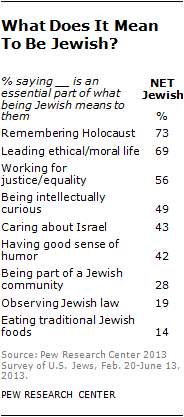
By several conventional measures, Jews tend to be less religious than the U.S. public as a whole. Orthodox Jews are a clear exception in this regard, exhibiting levels of religious commitment that place them among the most religiously committed groups in the country.
By several conventional measures, Jews tend to be less religious than the U.S. public as a whole.
Orthodox Jews are a clear exception in this regard, exhibiting levels of religious commitment that place them among the most religiously committed groups in the country.
Do you really want to be like Woody Allen and only think that being Jewish is:
- Lox and Bagels
- The Holocaust
- Just occasionally thinking about Israel
People of Jewish Background and Jewish Affinity who are not Jewish
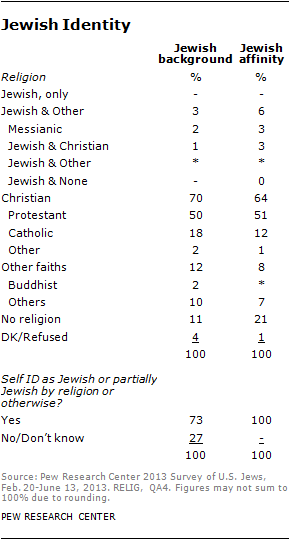 By definition, everyone in the Jewish background category was raised Jewish or had a Jewish parent. Having this kind of Jewish background is the key attribute that holds this category together. But why are these respondents not categorized as Jewish in the analysis contained in this report?
By definition, everyone in the Jewish background category was raised Jewish or had a Jewish parent. Having this kind of Jewish background is the key attribute that holds this category together. But why are these respondents not categorized as Jewish in the analysis contained in this report?
The reason for treating them separately from the Jewish population is that everyone in the Jewish background category either says they are not Jewish (by religion or otherwise) or espouses a religion other than (or in addition to) Judaism.
1.3 million people who are not classified as Jews say they have a Jewish mother.
Sophia’s the pomeranian’s Bark Mitzvah w/Lee Day & Rabbi Otis on Nat Geo Wild Spoiled Rotten Pets
[Is this what Reform Judaism has turning into?]
Conservative Movement to allow membership to non-Jews?
Ben Sales and A7 Staff , 29January2017 http://www.israelnationalnews.com/News/News.aspx/224038
Confronted by the growing level of intermarriage in the American Jewish community at large and in many Conservative congregations across the country, along with dwindling memberships, Conservative movement members will be voting on a measure from their umbrella body that would allow congregations to admit non-Jews as members
It’s time to come home! Nefesh B’Nefesh: Live the Dream 1-866-4-ALIYAH

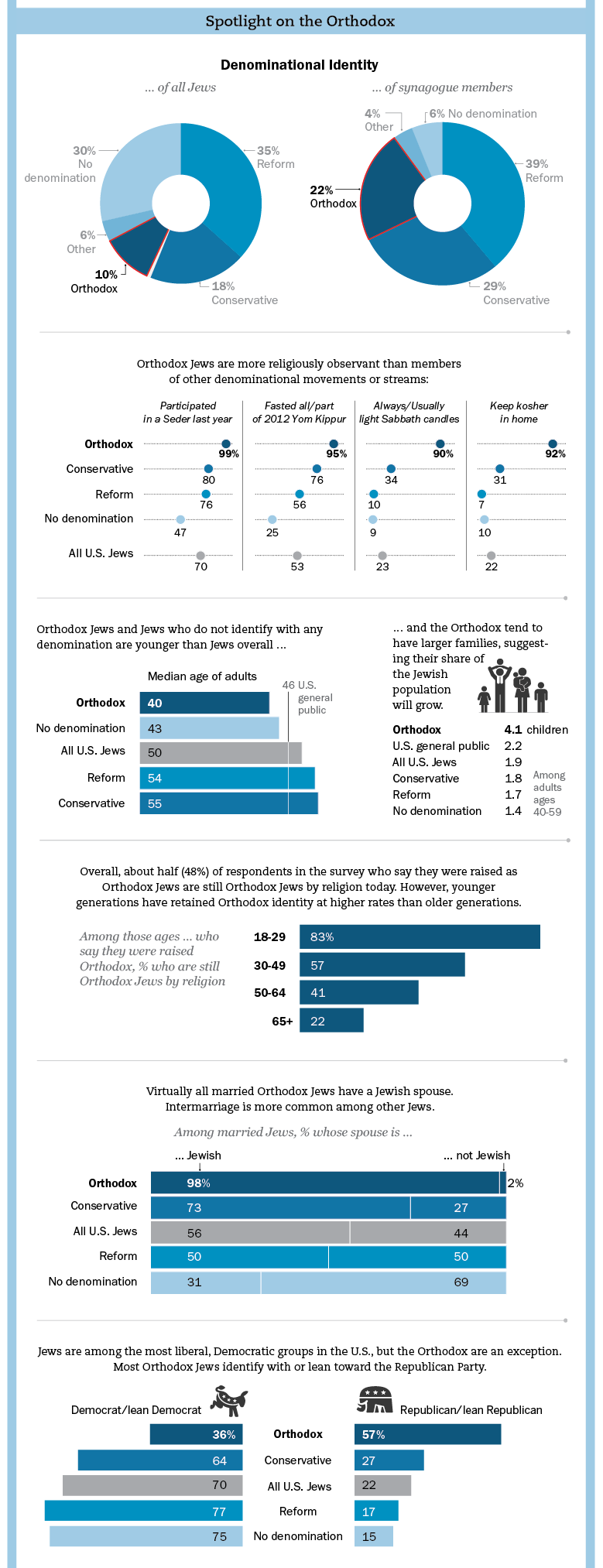

Jewish Culture, Revelation and Continuity
http://www.danielgreenfield.org/2013/11/jewish-culture-revelation-and-continuity.html
Posted by Daniel Greenfield @ the Sultan Knish blog Monday, November 25, 2013
The Pew survey, like the various more specific surveys of the Jewish community that come out from time to time, has told everyone in the Jewish organizational world what they already know. There is nothing in the survey that hasn’t been predicted, belabored and denied for decades. If its meaning had to be summed up in a single sentence, it would be that there can be no religion without revelation, no community without culture and no continuity without all of these.It really is that simple which is why so many insist on making it so complicated.
What the Pew survey really says is that there are really two Jewish communities in America. One that is an actual structured community and the other uses that name but is a community in name only. Most of the responses go right past that obvious point to arguing about semantics, theology and the number of Jews who can dance on the head of a pin.[wpex Read more]
Daniel Gordis had a passionate and moving piece on the decline of Conservative Judaism that is also fundamentally wrong.
Gordis states, “What really doomed the movement is that Conservative Judaism ignored the deep existential human questions that religion is meant to address.” That confuses religion with philosophy. Religion does address existential questions, but it does so through faith.
The F-word, “Faith” only appears once in Gordis’ entire essay. “Non-Orthodox Judaism is simply disappearing in America. Judaism has long been a predominantly content-driven, rather than a faith-driven enterprise, but we now have a generation of Jews secularly successful and well-educated, but so Jewishly illiterate that nothing remains to bind them to their community or even to a sense that they hail from something worth preserving.”
Gordis hits the point and then drives away as quickly as he can. American Judaism is content-driven, but its content has to be driven by faith or the content has no integrity.
“Looming unasked in Conservative circles is the following question: Can one create a community committed to the rigors of Jewish traditional living without a literal (read Orthodox) notion of revelation at its core? Conservative Judaism could have been the movement that made an argument for tradition and distinctiveness without a theological foundation that is for most modern Jews simply implausible,” Gordis writes.
The Pew survey already answers that question. Religion without revelation has no integrity of content. Without revelation, religion is mere philosophy. If the religion is not of divine origin, then it’s merely philosophy. And you don’t build a community around concepts only a fraction of its people would be interested in or understand.
Religion without revelation is random intellectual inquiry packaged as something more. Without a Divine core, it is reduced to searching for the “divine in all of us”. If there is no G-d who spoke to man and conveyed specific words, instructions and ideas, then all that remains is an aimless spirituality that provides no reason for maintaining the specific integrity of a community around it.
Gordis’ remedy is “deep existential and spiritual seriousness”. And no doubt this will appeal to divinity students. But you can’t build a religion around that. Not even in a community as literate as those to be found within American Judaism. “Deep existential and spiritual seriousness” is surprisingly boring when you have to actually sit through it. It’s not particularly engaging.
“While these laypeople were busy seeking a way to explain to their children why marrying another Jew matters, how a home rooted in Jewish ritual was enriching, and why Jewish literacy still mattered in a world in which there were no barriers to Jews’ participating in the broader culture, their religious leadership was speaking about whether or not the movement was halakhic or how one could speak of revelation in an era of biblical criticism,” Gordis says.
But if your laypeople are trying to figure out why these things matter, then your religious stream has already failed. In Orthodox Judaism, most laypeople are not trying to figure out how to explain these things; they take them for granted. It’s in the air they breathe and the water they drink. Likewise, they aren’t looking for serious existential answers. They absorb them early on and take them on faith.
That’s between a religion that is so embedded that it’s culture and a religion that is swimming upstream against culture.
If you dispense with Divine revelation, then all you have left is culture and community. You might be able to build a community around culture. American Jews have done so. But the culture depended on eroding differences. The more those differences eroded, the more American Jewish culture just became the Jewish contribution to America.
You don’t need to be Jewish to read and appreciate Bernard Malamud, Saul Bellow and all the other big names. You don’t need to be Jewish to watch a Neil Simon play. And their contemporaries who appeal to American Jews in their twenties and thirties either tend to be so cynical and toxic that they make Philip Roth seem downright Judeopositive or detached enough that they represent little except echoes of distant memories.
No one is going to stay Jewish for Michael Chabon and Jonathan Safran Foer. Despite their tattered drabs of Jewish culture, they’re less Jewish than their literary forebears who at least had a direct connection with the culture of the immigrants. And when you’ve exhausted Jewish-influenced memoir fiction, what’s left? YIVO Yiddish revivals? The Klezmatics? Documentaries about Jewish life in the twenties? Jerry Seinfeld? Another revival of Fiddler on the Roof with a more positive take on intermarriage? A Woody Allen retrospective?
The public secular Jewish culture of neurotic humor is common property. It doesn’t maintain communities. It more often disintegrates them. It’s laughing at the abyss by people who no longer remember why the abyss is a bad thing. From a defensive response to pain, Jewish humor has become nihilistic. It no longer remembers the pain it is laughing at and so its laughter has become senseless.
Culture is a powerful means of continuity when it is immersive.
The Orthodox child doesn’t play with Dr. Seuss picture books. She plays with picture books that illustrate the importance of doing good deeds. Instead of being taught nursery rhymes, she’s taught to chant Brachot; blessings to thank G-d for the food that she eats. The music she listens to and the cartoons she watches will also teach her religious values.
Then she’ll graduate to pop music that will consist of biblical verses set to catchy tunes. The Orthodox Jewish music industry is big business. It encompasses most modern music and often casually borrows tunes from popular music (though in all fairness, much of popular music does the same thing) and sets it to religious devotions or sayings.
While her secular Jewish counterpart hums a Lady Gaga song, she’s humming, “The G-d who created joy and happiness” or “Oh Lord, open my lips so that my mouth may sing your praises.” The music may not be all that different. But the ideas are very much so.
When she reads? It’s less likely to be 50 Shades of Grey because there are Orthodox comics, mystery novels, teenage detectives (of both genders), biographies, historical novels, romance novels, self-help books, novels and the whole variety of alternative literature.
I won’t claim that this Orthodox popular culture is of a high caliber; but then neither is the popular culture that it’s displacing.
That’s not to say that pop culture doesn’t still penetrate Orthodox communities; but it does so to a lesser degree depending on the cultural integrity of the community. Modern Orthodox Jews like me are more likely to be familiar with both worlds. On the other end of the spectrum, Chassidic Jews may even reject the Orthodox pop music as inappropriate, opting for something more classical.
Communities also require private languages. Instead of empty Yiddish revivals, in much of the Orthodox Jewish world, a form of Judeo-English has arisen that is the counterpart of the Judeo-German known as Yiddish, the Judeo-Spanish known as Ladino or the Judeo-Aramaic of the Talmud or the Judeo-Arabic that Maimonides wrote in.
Derived from the language of scholarship, “Yeshivish” is a jargon full of inside jokes and wry humor referencing the techniques of study and the practices of the religion. It mixes Hebrew and Yiddish to create a new language.
The common denominator in all these things, from the religious pop songs, to the novels, which inevitably have religious morals built in, and the language, which is built around religious values, is that they integrate the assumptions of faith into daily life. They make religion into culture. And they make faith into culture.
The Orthodox Jew casually says “G-d willing” and “Thank G-d” to everything; inculcating the assumptions of faith into daily life. That used to be a common habit among Jews in Europe.
The hypothetical girl may still end up leaving, but she’s less likely to do so because she is part of a community with its own culture and values. And even its own language. She’s not there for the deep existential seriousness. The seriousness has always been a part of her life. But it’s overlaid with a private cultural language that encompasses the everyday communal experience.
Faith isn’t an external assumption imposed on her everyday life that is foreign to it. Faith is her culture. It’s not expressed in high-flown language of sermons, but in the everyday language of her life.
To emerging generations of liberal Jews, their own religion is foreign to them. They have to conquer the instinctive skepticism bred into them by a secular culture to be part of it. Orthodox Jews have to conquer an instinctive skepticism of secular culture to leave. And that’s a major difference.
Orthodox Judaism in America would have failed all over again, as it did before WW2, without the creation of a cultural community that could speak to young people. Its leaders put the emphasis on the construction of an educational complex, and indeed that is very important, but Modern Orthodoxy shows that an educational system that doesn’t permeate into the home environment is more fragile.
And these solutions are not unique.
Evangelical Christianity has its own set of songs, novels and cartoons with the same goal; the maintenance of an immersive moral culture that makes a religious community viable in a secular culture.
Any liberal streams of Judaism that reject the premise that a community is maintained through an exclusive culture and that religion is built on faith in revelation cannot survive. And they can’t duplicate Orthodox Judaism’s success without adopting those assumptions.
Liberal Judaism discarded the idea that Jews were a race. Then discarded the idea that Judaism represented a unique Divine revelation. Then discarded communal exclusivity and integrity.
With those three things thrown away; what possible basis for continuity can there be?
If Jews are not part of a single family, as the Bible specifies, and only a religion, then why not intermarry as long as the other partner adopts the religion or works out some joint arrangement? If Judaism does not possess an exclusive revelation from G-d, then why stick with it because of an accident of birth into a people that is nothing more than a cultural community?
And if Jewish culture consists of novels that anyone can take out at the library, Woody Allen movies eating Chinese food on Christmas, questioning things and talking a lot with your hands; why bother maintaining a culture that anyone can be a part of and that, therefore, no one needs to be a part of?
The racial, religious and communal reasons for maintaining the Jewish people are interwoven. You can’t discard one without toppling the whole thing. And if you discard all three, then you certainly aren’t going to keep it going with a copy of the The Yiddish Policemen’s Union and an interfaith Passover seder with passages commemorating civil rights and LGBT liberation.
The liberalizing fallacy has been that each generation could make concessions to modernism by discarding some things that “no modern person takes seriously anyway” while assuming that the next generation would want to keep the things that they kept, instead of throwing away more things to adapt to a modernity that was continually becoming more hostile to traditional religious values.
Eventually throwing things away became Liberal Judaism. And that Judaism became the nothingness it sought to be. The liberal impulse made that Judaism into liberalism, its synagogues into community activist groups and its theology into social justice. Its Rabbis excelled at the language of moral seriousness; but like all Western liberal clergy they had nothing to be morally serious about.
“As Conservative writers and rabbis addressed questions such as ‘are we halakhic,’ ‘how are we halakhic,’ and ‘should we be halakhic,’ most of the women and men in the pews responded with an uninterested shrug. They were not in shul, for the most part, out of a sense of legally binding obligation. Had that been what they were seeking, they would have been in Orthodox synagogues. They had come to worship because they wanted a connection to their people, to transcendence, to a collective Jewish memory that would give them cause for rejoicing and reason for weeping, and they wanted help in transmitting that to their children,” Gordis writes.
No doubt they did indeed want those things. But you can’t have those things without binding obligations.
Connections come from binding obligations, not casual ones. To cry and be happy, you need an emotional connection that is more than just an event of convenience. Peoplehood, like marriage, must be forever if it is to mean anything at all.
People who casually want deep spiritual experiences and community will never find them without making permanent commitments.
Judaism is a commitment of faith. It is a religious civilization upheld by an ancient family that builds its phantom kingdoms of faith in every place of its wanderings and then packs them up again into its invisible knapsack of faith. That is its culture and its meaning.
The Jew exists because of faith. Without faith, there are no Jews. Without faith, there are only archeologists of Judaism poring through the ruins and bones of what used to be a religion and wondering how they can make it live again.
Without faith, culture and community have no meaning. Without integrity of culture and community, faith has no means of maintaining its expression.
Faith is not grappling with difficult existential questions. It is best expressed in the dialogue between the Prophet Ezekiel and G-d. “And He said unto me: ‘Son of man, can these bones live?’ And I answered: ‘O Lord GOD, Thou knowest.” (Ezekiel 37:3)
And so faith answers its own question.
That is the essential humility that is the true character of the prophet. Liberal streams of Judaism claim to focus on prophetic value of social justice. But the calls of the prophets for justice did not come from them. They came from G-d. In their natural state they were humble men, like Moses, who did not strive to impose their will on others, but waited to hear what G-d would tell them to do.
That humility of action is faith. And without that humility, there is no room for faith or G-d.
Consider this discourse from Kaufmann Kohler, a Reform Rabbi from a century ago. “The issue
today is no longer between Reform and Orthodox, but between a world with G-d and a world without G-d. How, then can the destinies of home and communities, the guardianship of souls and the future of humanity be entrusted to men who, in a time when the foundations of morality are shaken and the peace of the world quivers under the fierce contest of ideas, lack power and principle, wavering and oscillating between agnosticism and belief, between Judaism and Unitarianism and a dozen other isms?”
Having said all that, Kohler then went on to argue that Judaism was just the shell for a kernel of ethical and moral truth and that the essence of religion was social justice. But one does not need religion to propound social justice. That is something that Kohler’s successors know, but are unable to do anything about because their religion is the common modern secular faith of political activism.
There is no prophetic vision without G-d. The prophetic vision of movements that have abandoned G-d is nothing but men who have made themselves into gods, prophesying their own prophecies.
Kohler indicted Orthodox Jews for failing to “impart life to the dry bones of Judaism”. But life comes from faith. That is the essence of the Ezekiel prophecy that Kohler went right past in the search for prophetic social justice. The issue is still between a world with G-d and a world without Him.
The Pew survey makes it clear that the future of the Jewish community belongs to those who build communities based on a world with G-d whose leaders and people don’t waver in their beliefs.
The Judaism of those who trade the birthright of faith for the pottage of social justice has no future. Judaism is not the kernel for a handful of ethical concepts. Its ethical concepts are part of it just as its community, its religion, its culture and its people must be one organic entity.


